[ad_1]
Until recently “innovation” was not a word associated with audio conferencing. It has seen very little change since its introduction in the 1980's because Ma Bell had it tucked away in its far-flung call centers. Just enough engineering was done to offer some basic services, but everything else was done manually and users paid a premium. As a result, medium and small businesses rarely used it. The good news emerging from this bleak history is that a populist revolution has begun.
As the decades rolled, Ma Bell's austere audio conferencing services conditioned users to have low expectations. When AT&T was divested in the mid-1980's the Baby Bells repeated the practices with very few changes other than reservation-less conferencing which issued a permanent call in PIN and 800 number. The current fare of services has not progressed from here.
The crazy thing about this circumstance is that us generally demanding consumers stopped asking long ago if audio conferencing could do better. We had been so beaten down by Ma Bell's drill sergeants that we simply got in line, cup in hand.
Audio conferencing has never had a technology champion. The market leader historically was the lethargic AT&T whose once innovative Bell Labs dabbled with web technologies and then broke apart. The Baby Bells carried on this tradition. Therefore, the industry has never had an innovative advocate. A new breed of entrepreneurial innovators is beginning a populist revolution.
The cornerstone of innovation is being able to deliver more services at less cost. The convergence of phone and web technologies enables a richer user experience. However, this convergence is easier with two-way phone calls, but much more complicated with audio conferencing. Each audio conference is unique. One conference call may have 10 participants while the next one has 400. Regular phone switches and Internet routers cannot “bridge” such calls. This requires specialized audio conferencing technologies.
Web 2.0 audio conferencing has finally brought the benefits of web-based services. In contrast to same-old-same-old, these services enable such features as:
- Group Call-With one tap on your iPhone calling 10, 50 or 100 people at once without having to notify them, send a PIN and dial in number, set a time, wait for stragglers, etc.
- Add Participants “On the fly” – Adding additional participants while a conference call is in progress without interrupting the conversation.
- Record – Getting an MP3 recording of your weekly sales training to provide to new hires.
- Web Console – Web controls for online contact lists, monitoring calls, video training, help, technical support, account and billing details.
- Security & Privacy – Ability to select easily the right privacy level to prevent interlopers on important calls, or where privacy rules demand it (like HIPAA).
None of the features above were available with traditional services. Why? It's the nature of the technologies. Traditional phones are about connecting wires with switches. Web technologies are about managing “data packets” passing through routers. Also, traditional phones networks are government regulated whereas Internet systems are not. All these differences make for technologies that were apples and oranges historically. None of the big players were investing in audio conferencing R&D until intrepid entrepreneurs started looking at this communications problem in the late 1990's.
Web 2.0 audio conferencing blends the best of both worlds. However, be aware that many same-old-same-old audio conferencing providers are erecting websites in front of their traditional, aging boxes, pretending to be web-i-fied, and luring you with all sorts of “bait-and-switch” bargains. Cheap is not beneficial if it hurts your productivity and that of the people you want to bring together. People-time cost is your greatest expense, not the small cost of your audio conferencing minutes. Invest in your productivity. Being forewarned is forearmed.
To learn more, Google “Web 2.0 audio conferencing”.
© Copyright 2010. Leader Phone® and Michael McKibben. All Rights Reserved.
[ad_2]
Source by Michael McKibben

